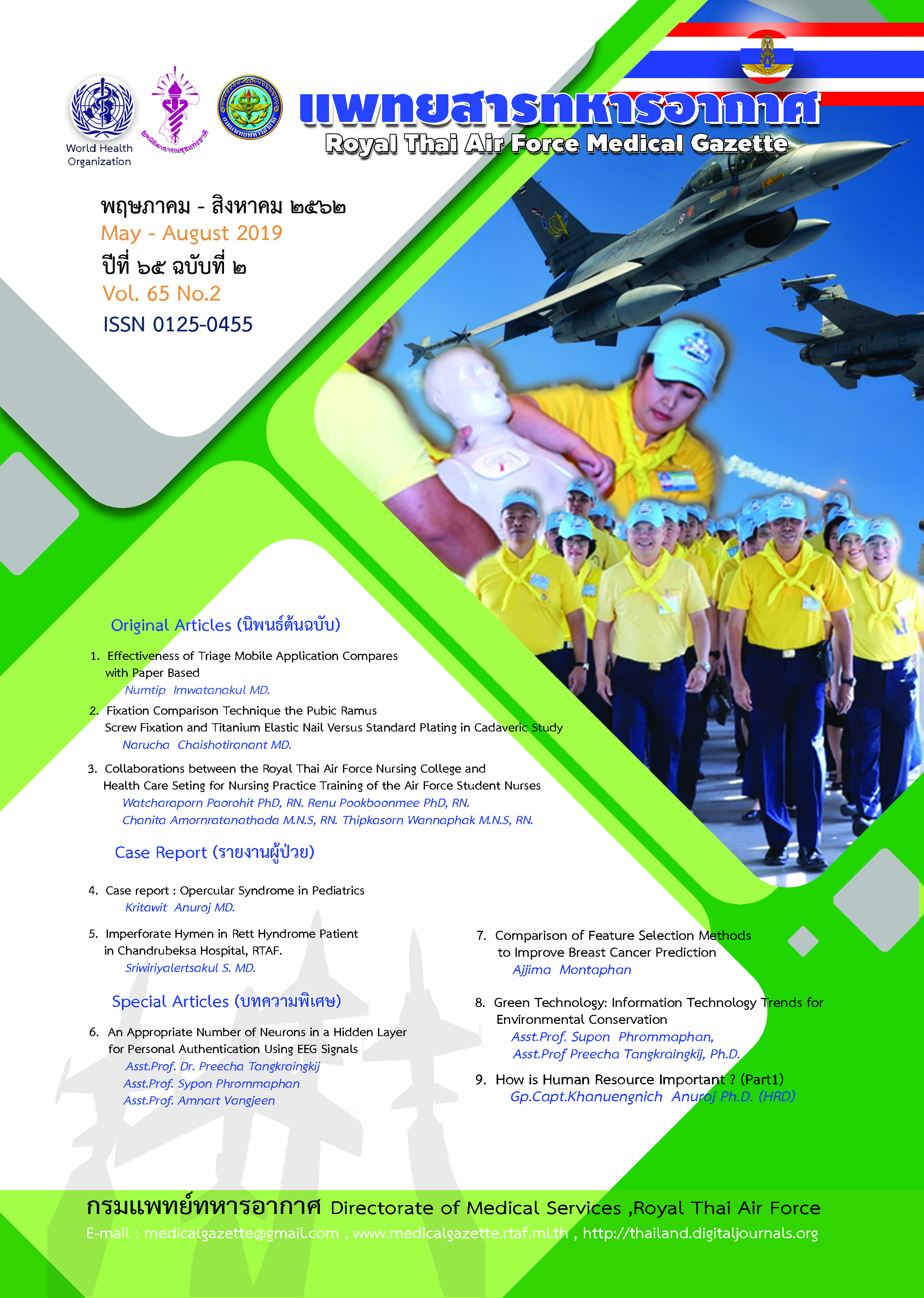Collaborations between the Royal Thai Air Force Nursing College and Health Care Seting for Nursing Practice Training of the Air Force Student Nurses
Main Article Content
Abstract
Objective : The objective was to investigate the characteristic of the collaborations between the Royal Thai Air Force Nursing College and health care setting for nursing practice training of the Air Force Student Nurses.
Material and method : This research was a qualitative research design. Participants were 15 nurse
instructors and administrators, Royal Thai Air Force Nursing College and 28 staff nurses and nurse
administrators at health care setting. Structure interview of 7 Dimensions of collaboration designed
by Travis was used for focus group and in-depth interview. Trustworthiness was done by Lincon and Guba method. Data were analyzed by content analysis.
Results : The revealed focus of collaborations between the Royal Thai Air Force Nursing College and health care setting were shown as a routine work which carried out from the past until present. The structure of collaboration was the coordinators cooperated at all levels of the settings. The process of collaboration was done by determine objectives of nursing practices training. The outcome of collaborations was self
development and knowledge exchange among nurse instructors and staff nurses. Actors of collaborations were conducted by position and job assignment. Formalization was academic mutual development and followed regulations of the health care settings. Resources in the setting were reasonable used and
supporting each other. Focus of power depended on ward objectives that allowed the students to practice nursing and the decision making was done by administrators. Focus of Control was under professional standard. The goal of collaboration was skill development of the nurse instructors and staff nurses and enhance mutual benefit.
Conclusion : The collaborations between the Royal Thai Air Force Nursing College and health care setting for nursing practice training of the Air Force Student Nurses could motivate the professional nursing development. The collaboration took place at all levels and the focus of control emphasized on the standard of practice.
Article Details
บทความที่ได้รับการตีพิมพฺเป็นลิขสิทธิ์ของวารสาร
References
Annexes. GENEVA: WHO Press; 2013.
2. Foster O, MarksMaran N. Nursing students’ expectations and experiences of mentorship,
Nursing Education Today, 2015 Jan;35(1):18-24.
3. Graneheim, BL. Qualitative content analysis in nursing research: concepts, procedures and
measures to achieve trustworthiness. Nurse Education Today, 2004;24,105–12.
4. Lincon,Y.S.,& Guba, E. G. The Constructivist: Left Coast Press; 2013.
5. Travis L, Hart A, Hardin S, Harwell K. Academic –Service partnerships: Seven dimensions of successful
collaboration, Journal of Nursing Education and Practice, 2013. Jan; Vol.3, No.1.
6. Harvath T, Flaherty-Robb M, Talerico W, Hayden KC. Best Practices Initiative: Nurturing
Partnerships that Promote Change, 2015.
7. Barger S, Das EA., Academic-Service Partnership: Ideas That Work, Journal of Professional Nursing, 2004; Vol 20,
No 2 (March-April), 97-102.
8. อมรรัตน์ ภิญโญอนันตพงษ์. การพัฒนารูปแบบความร่วมมือทางวิชาการด้านการสอนระหว่างอุดมศึกษาของรัฐ. ปริญญานิพนธ์ปริญญา
ดุษฎีบัณฑิต. กรุงเทพฯ: มหาวิทยาลัยศรีนครินทรวิโรฒ; 2546.
9. Elliott K, Marks-Maran N, Diane R, Bach R. Teaching student nurses how to use electronic patient records
through simulation; 2018.
10. Walter L, Davies H, Nutley S. Increasing research impact through partnerships: Evidence
from outside health care. Journal of Health Services Research and Policy, S; 2003:58-61.
11. Hass BK, Deardorff KU, Klotz L. et.al Creating a collaborative partnership between academia
and service; Journal of Nursing Education; 2002:518-23.
12. กัญญ์สิริ จันทร์เจริญ, ภัทรจิต เจริญศักดิ์, ลดาวัลย์ คงนวล, สาลิตา หัดสะแหละ, เสาวลักษณ์ นิลภูศรี,
อทิตยา เอียดหวัง. ทัศนคติของการทํางานบริการสุขภาพของผู้สําเร็จการศึกษา วิทยาลัยพยาบาลบรมราชชนนี
สงขลา. สงขลา: วิทยาลัยพยาบาลบรมราชชนนี สงขลา; 2549.
13. ยุวดี ฦาชา, อรสา พันธ์ภักดี, พรศรี ศรีอัษฎาพร, สมใจ พุทธาพิทักษ์ผล, โสพรรณ โพทะยะ, พรทิพย์ มาลาธรรม,
และคณะ. ความร่วมมือระหว่างสถาบันการศึกษา และ สถานบริการสุขภาพเพื่อสร้างบัณทิตที่มีคุณภาพ : กรณี
ศึกษา. วารสารสภาการพยาบาล 2548;20:1-16.
14. Hall- Barrow J, Hodgest LC, Brown PA. Collaborative model for employee health and
nursing education: successful program, AAOHNJ 2001;49(9):429-36.


